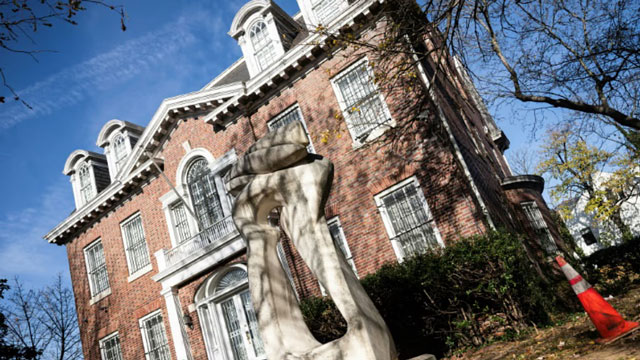Daijiworld Media Network - Washington
Washington, Nov 22: The quiet, tree-lined neighborhood of Kalorama — home to diplomats, dignitaries and even former US presidents — is today dotted with haunting reminders of global political upheavals. Empty embassies, overgrown lawns and shuttered diplomatic residences stand as mute witnesses to years of conflict, sanctions and broken alliances.
What once were bustling centers of international engagement have now slipped into neglect, their fates tied to turbulent political changes thousands of miles away.

In September, the long-abandoned Syrian Embassy briefly drew attention after workers finally cleared years of wild vegetation choking the property. The building, closed since 2014 amid Syria’s civil war, saw the country’s flag raised again — a symbolic gesture following the US announcement on November 10 permitting its reopening after Syria’s new president, Ahmed al-Sharaa, visited the White House.
Yet the structure is in deep disrepair. Former Syrian diplomat Bassam Barabandi, who resigned in 2013 after helping opponents of the Assad regime, says large sections of the embassy were already condemned over a decade ago. “So, just imagine its state now,” he remarked.
Nearby, the once-grand Syrian ambassador’s residence sits in similar decay, with gas disconnection notices still hanging from the door and overgrown hedges occasionally trimmed only because irritated neighbors complained.
Just a few blocks away, and in the shadow of the Obamas’ mansion, stands the deserted Embassy of Afghanistan. Its closure in March 2022, months after Kabul fell to the Taliban, was abrupt and emotional.
“Soon the embassy simply wasn’t there anymore,” recalled postal worker Trina Thompson, who has served the neighborhood for 25 years.
Former deputy ambassador Abdul Hadi Nejrabi oversaw the final handover — a moment he remembers vividly. With the Taliban now ruling Afghanistan, he and his colleagues represented a government that no longer existed. Bank accounts were frozen, salaries stopped, and finally, the US State Department instructed them to close the mission.
“We checked every room. Then we locked the door, and I handed over the key,” he said.
The State Department’s Office of Foreign Missions now bears responsibility for maintaining such embassies. Under the Vienna Convention, the US must safeguard these properties even when diplomatic ties collapse.
At present, the US is responsible for 29 foreign diplomatic buildings:
– 3 linked to Afghanistan
– 6 belonging to Venezuela
– 11 associated with Iran
– 3 Chinese properties
– 6 Russian buildings
For Russia, the closures remain a sore point. The shut-down facilities — including consulates in Seattle and San Francisco and a sprawling compound in Maryland — were locked in retaliation for Moscow’s alleged interference in the 2016 US election.
Calling the US actions “illegal” and “bordering on theft,” the Russian Embassy says denying access to its own properties deepens the “toxic legacy” of recent years.
Meanwhile, the Iranian Embassy, sitting empty since 1980 after the Islamic Revolution, remains frozen in time — a relic of a diplomatic relationship yet to thaw.
From Syria’s battered compound to Afghanistan’s deserted mission, these silent structures across Kalorama stand as stark symbols of fractured ties — architectural reminders of the volatile crosswinds shaping global diplomacy.